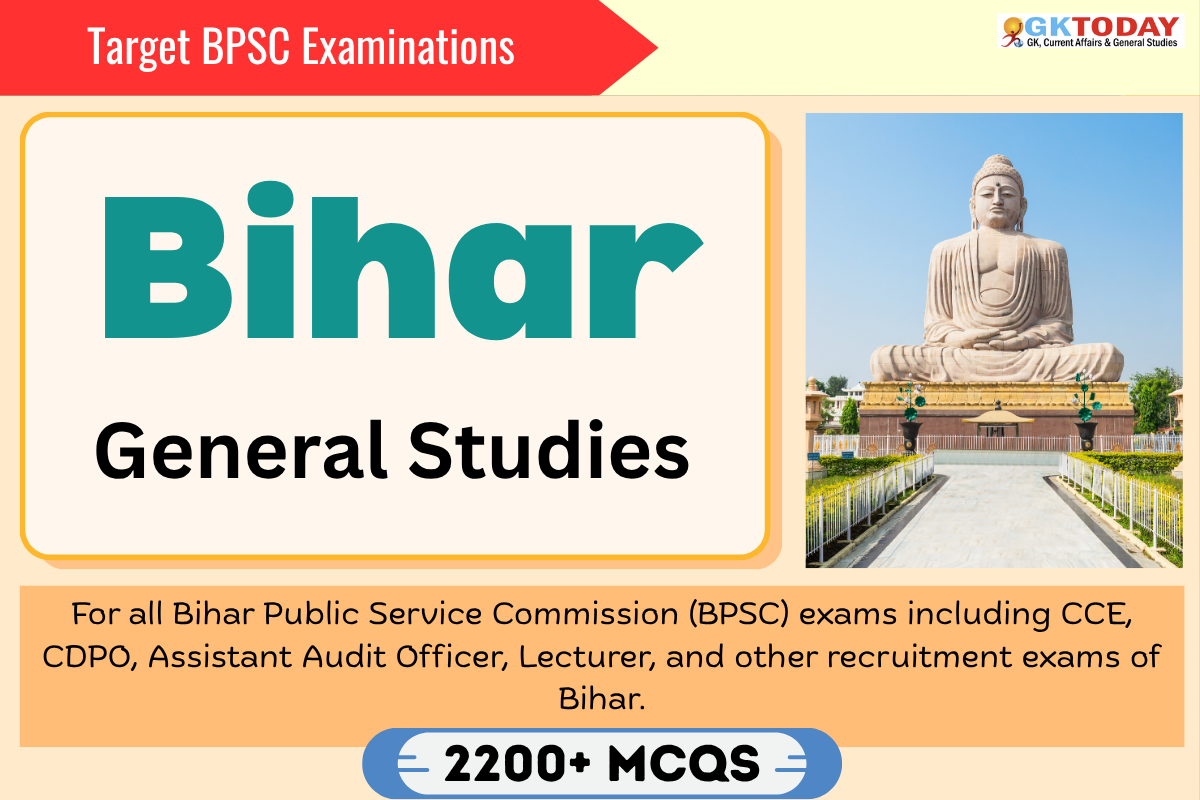States PCS: Bihar GK for BPSC and other Bihar PCS Exams
For all Bihar Public Service Commission (BPSC) exams including 67th-70th CCE, CDPO, Assistant Audit Officer, Lecturer, and other recruitment exams of Bihar.
1. Which of the following is the State Flower of Bihar?
[A] Rose
[B] Lotus
[C] Kachnar
[D] Lily
Show Answer
Correct Answer: C [Kachnar]
Notes:
Kachnar is the State Flower of Bihar. The botanical name of Kachnar is Bauhinia variegata. It is cultivated as an ornamental plant. It has various medicinal properties.
2. At the confluence of which two rivers, the foundation of the city of Pataliputra was laid by the King Udayin?
[A] Champa and Son
[B] Ganga and Champa
[C] Ganga and Son
[D] Ganga and Beas
Show Answer
Correct Answer: C [Ganga and Son]
Notes:
King Udayin was the ruler of Haryanka dynasty. He was the son of Ajatashatru and grandson of King Bimbisara. King Udayin ruled Magadha from 460 BCE to 440 BCE. He laid the foundation of the city of Pataliputra at the confluence of
two rivers, the Son and the Ganga. King Udayin was succeded by Anuruddha.
3. Which empire was divided into 26 provinces called Bhukti, Pradesha and Bhoga?
[A] Gupta
[B] Shunga
[C] Maurya
[D] Nanda
Show Answer
Correct Answer: A [Gupta]
Notes:
Gupta empire had a hierarchy of administrative divisions from top to bottom. The empire was called by various names such as Rajya, Rashtra, Desha, Mandala, Prithvi and Avani. It was divided into 26 provinces, which were styled as Bhukti, Pradesha and Bhoga. Provinces were also divided into Vishayas and put under the control of the Vishayapatis. A Vishayapati administered the Vishaya with the help of the Adhikarana (council of representatives), which comprised four representatives: Nagara Shreshthi, Sarthavaha, Prathama Kulika and Prathama Kayastha. A part of the Vishaya was called Vithi.
4. Which of the following sutra or text is related to Bodhisattva Avalokiteshwara?
[A] Prajnaparamita
[B] Vimalakirti-nirdesha
[C] Sukhavati-vyuha
[D] Suddharma-pundarika
Show Answer
Correct Answer: D [Suddharma-pundarika]
Notes:
Suddharma-pundarika is related to Bodhisattva Avalokiteshwara. Suddharma-pundarika means White Lotus of the True Dharma, also often esoteric and includes the Avalokiteshwara Sutra which is a prayer to Bodhisattva. Avalokiteshvara is the bodhisattva who embodies the compassion of all Buddhas. This bodhisattva is variably depicted, described and portrayed in different cultures as either male or female.
5. Who was the author of “Mulamadhyamaka-karika”?
[A] Nagarjuna
[B] Nigrodha
[C] Kumaravijaya
[D] Shantideva
Show Answer
Correct Answer: A [Nagarjuna]
Notes:
Nagarjuna was the author of “Mulamadhyamakakarika”. It is the foundational text of the Madhyamaka school of Mahayana Buddhist philosophy. Madhyamaka means ‘the middle way’. The book was written in 150AD. For this book, Nagarjuna took the idea from two philosophies of Buddha: eternalism and annihilationism—the belief that the soul exists forever and that the soul is annihilated at death or between materialism and nihilism. Nagarjuna took this idea and expanded it to create the philosophy that is known as Madhyamaka.
6. In which city/distrcit of Bihar, the second Bahá’í House of Worship in India is planned to be constructed?
[A] Patna
[B] Gaya
[C] Bhagalpur
[D] Bihar Sharif
Show Answer
Correct Answer: D [Bihar Sharif]
Notes:
The second Bahá’í House of Worship in India is planned for Bihar Sharif, making it a significant religious site in Bihar.
7. What is the appropriate student-teacher ratio that Department of Education, Bihar wants to achieve?
[A] 15:1
[B] 58:1
[C] 40:1
[D] 50:1
Show Answer
Correct Answer: B [58:1]
Notes:
Department of Education, Bihar wants to achieve the appropriate student-teacher ratio of 58:1. They want to improve the quality of teaching and Quality of Education.
8. Which ruler had given the statement “All humans are my children” ?
[A] Chandragupta Maurya
[B] Hemu
[C] Ashoka
[D] Bimbisara
Show Answer
Correct Answer: C [Ashoka]
Notes:
Ashoka had given the statement “All humans are my children”. Under the guidance of Monk Nigrodha, King Ashoka followed the path of peace and non-violence. After the conquest of Kalinga, Ashoka began feeling remorse as he personally witnessed the remorse. When Ashoka met Monk Nigrodha then Ashoka embraced the teachings of Buddhism, and renounced war and violence. He sent out missionaries to travel around Asia and spread Buddhism to other countries. Ashoka implemented principles of ahimsa by banning hunting and violent sports activity and ending indentured and forced labor.
9. Who was the Governor-General of India during the revolt of 1857?
[A] Earl Cornwallis
[B] Warren Hastings
[C] John Shore
[D] Lord Canning
Show Answer
Correct Answer: D [Lord Canning]
Notes:
Lord Canning was the Governor-General of India during the revolt of 1857. He was a British statesman. He became the first Viceroy of India after the transfer of power from the East India Company to the Crown of Queen Victoria in 1858 after the rebellion was crushed. Canning is credited for ensuring that the administration and most departments of the government functioned normally during the rebellion and took major administrative decisions even when peak of the Rebellion in 1857 including establishing of the first three modern Universities in India.
10. Siberian birds are migratory birds and they migrate to all tropical countries where winters are warmer. In which bird sanctuary of Bihar, Siberian birds come after migrating from their native place?
[A] Buxar Bird Sanctuary
[B] Kusheshwar Asthan Bird Sanctuary
[C] Sanjay Gandhi Biological Park
[D] Kanwar Lake Bird Sanctuary
Show Answer
Correct Answer: D [Kanwar Lake Bird Sanctuary]
Notes:
Siberian birds migrate in search of Warm climate and food. In Bihar, they come to Kanwar Lake Bird Sanctuary. This bird sanctuary is located in the Begusarai district of Bihar. It is Asia’s largest freshwater oxbow lake. It is approximately six times the size of the Bharatpur Sanctuary. It was declared as a Ramsar site in 2020. It is the first Ramsar site of Bihar.

